#eocene
Text
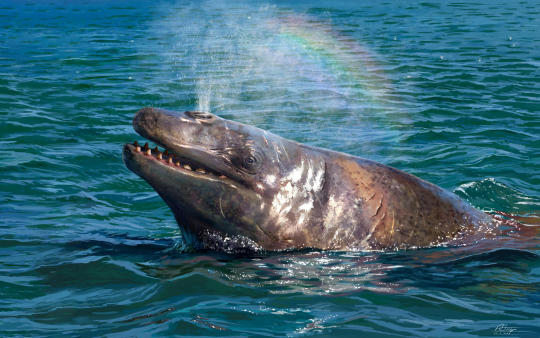
Perucetus colossus by Anthony J. Hutchings.
3K notes
·
View notes
Text

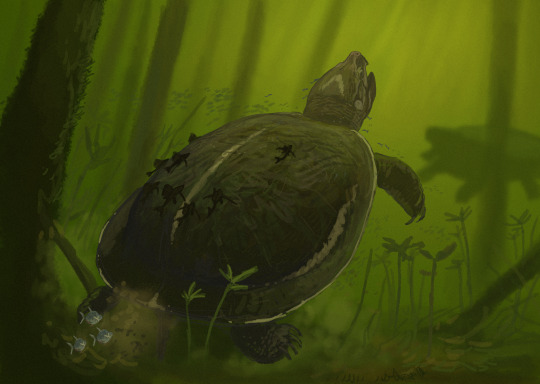


Results from the #paleostream!
Trachelosaurus, Peltocephalus, Chakisaurus and Mixtotherium.
726 notes
·
View notes
Text


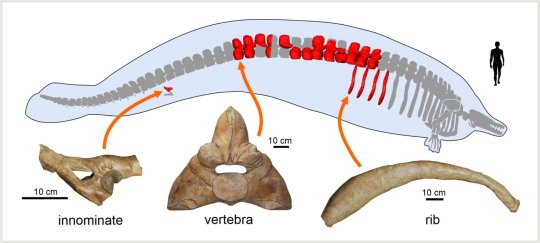
I know I usually talk about crocs, but this is too good not to share. A new giant basilosaurid whale with weird anatomy from the Eocene of Peru.
Perucetus colossus is a peculiar animal. It's bones were incredibly thick and incredibly dense, very much unlike those of modern whales and even more extreme than even those of the thicker basilosaurids (aptly named Pachycetinae i.e. thick whales). These adaptations have been compared to modern manatees and dugongs.
Know the weight range is highly dependent on what you base the math on. Using manatees as a proxy, you get a weight of "only" 85 tons....using extreme values for whales a whopping 340 tons. Mean values for whales a still really big 180 tons. This could indicate that Perucetus rivaled the Blue Whale as the worlds heaviest animal ever.
The ecology is poorly understood tho. We know basilosaurids preferred coastal waters, and with all the similarities to manatees it is reasonable to assume that Perucetus was a shallow water animal itself. It also likely wasn't the fastest swimmer. And the lack of a skull basically means we can't say much on its diet. We can wager a guess and say it wasn't a predator because, you know....it also likely wasn't a grazer. Cool as it would be, we don't really have herbivorous whales like that so its incredibly unlikely. The two more likely suggestions are that it lived on small animals burried in the ocean floor, sorta like a grey whale. Or that it was a scavenger like a sleeper shark (tho I find that suggestion far less likely, giving me scavenging T.rex vibes ngl). But again, once we get a skull we can talk about this better.
Sidenote I do find the name a little underwhelming. It's a bizarre animal and the best we could come up with is "Colossal whale from Peru". I'm also not a mammal person, but from what I'm being told the silhouette is a little exaggerated and it wasn't necessarily that thick in life.
Life reconstruction by A. Gennari, paper can be found here
A heavyweight early whale pushes the boundaries of vertebrate morphology | Nature
#perucetus#basilosauridae#paleontology news#palaeoblr#prehistory#eocene#early whale#evolution#science#whale
2K notes
·
View notes
Text

Imagine a hefty bird that stood taller than a full-grown human with a huge, crushing break. This Fossil Friday, meet Gastornis gigantea. This powerful bird was more than 6 ft (1.8 m) tall and weighed over 330 lbs (150 kg). It lived some 55 million years ago during the Eocene. Once assumed to be a carnivore that hunted small animals, scientists now think this extinct avian was actually a vegetarian related to ducks and geese.
Photo: © AMNH
#science#amnh#fossil#museum#natural history#nature#animals#gastronis gigantea#fossil friday#paleontology#birds#did you know#fact of the day#eocene
905 notes
·
View notes
Text

Hi there,
Perucetus Colossus, the newly described basilosaur from the Eocene of Peru, probably the heaviest animal on earth
986 notes
·
View notes
Text


The archeocete Perucetus colossus dives through a coastal bloom of jellyfish in the Pisco Basin (southern Peru), some time during the Eocene (with bonus multiview).
I originally intended to add epibionts to this reconstruction (reflecting the specialized communities found on many living whales, especially baleen whales). Yet, interestingly, it appears that most animal epibionts and ectoparasites of modern cetaceans, such as whale barnacles (Hayashi et al. 2013) and remoras (Friedman et al. 2013), only appeared in the Neogene or late Paleogene, or have a poorly known (co-)evolutionary history, like whale lice (Pfeiffer 2009, Iwasa-Arai & Serejo 2018) and pennellids (large parasitic copepods) (Hermosilla et al. 2015). So, no epibionts* for big lad Perucetus!
References and notes about the reconstruction:
*animal epibionts. Unicellular eukaryotes like diatoms were most likely present on early cetaceans, given their prevalence on modern large marine animals (Ashworth et al. 2022). Of course, it is possible that other animals (i.e., early, less specialized representatives of modern groups, or different taxa altogether) were also already exploiting the surfaces offered by these early whales; however, this remains entirely speculative.
The reconstruction of Perucetus proposed in its original description (Bianucci et al. 2023) includes some rather odd (if interesting) choices about soft tissues, including limbs with webbed and distinguishable fingers, and a manatee-like tail. While these choices might be defendable in light of the rather basal status of Perucetus among cetaceans, I opted for a more derived look based on the assumption that fully marine cetaceans like basilosaurids would have probably rapidly acquired hydrodynamically favorable adaptations, pushing them towards a more familiar Neoceti-like appearance (even though Perucetus itself was likely a poor swimmer (Bianucci et al. 2023), it seems likely to me that this was a secondarily acquired trait, given the less extreme morphology of other basilosaurids).
Reconstruction in the multiview scaled to ~18 m in length after the estimations of Bianucci et al. (2023).
References:
Ashworth, M. P., Majewska, R., Frankovich, T. A., Sullivan, M., Bosak, S., Filek, K., Van de Vijver, B., Arendt, M., Schwenter, J., Nel, R., Robinson, N. J., Gary, M. P., Theriot, E. C., Stacy, N. I., Lam, D. W., Perrault, J. R., Manire, C. A., & Manning, S. R. (2022). Cultivating epizoic diatoms provides insights into the evolution and ecology of both epibionts and hosts. Scientific Reports, 12(1), Article 1. https://doi.org/10.1038/s41598-022-19064-0
Bianucci, G., Lambert, O., Urbina, M., Merella, M., Collareta, A., Bennion, R., Salas-Gismondi, R., Benites-Palomino, A., Post, K., de Muizon, C., Bosio, G., Di Celma, C., Malinverno, E., Pierantoni, P. P., Villa, I. M., & Amson, E. (2023). A heavyweight early whale pushes the boundaries of vertebrate morphology. Nature, 620(7975), Article 7975. https://doi.org/10.1038/s41586-023-06381-1
Friedman, M., Johanson, Z., Harrington, R. C., Near, T. J., & Graham, M. R. (2013). An early fossil remora (Echeneoidea) reveals the evolutionary assembly of the adhesion disc. Proceedings of the Royal Society B: Biological Sciences, 280(1766), 20131200. https://doi.org/10.1098/rspb.2013.1200
Hayashi, R., Chan, B. K. K., Simon-Blecher, N., Watanabe, H., Guy-Haim, T., Yonezawa, T., Levy, Y., Shuto, T., & Achituv, Y. (2013). Phylogenetic position and evolutionary history of the turtle and whale barnacles (Cirripedia: Balanomorpha: Coronuloidea). Molecular Phylogenetics and Evolution, 67(1), 9–14. https://doi.org/10.1016/j.ympev.2012.12.018
Hermosilla, C., Silva, L. M. R., Prieto, R., Kleinertz, S., Taubert, A., & Silva, M. A. (2015). Endo- and ectoparasites of large whales (Cetartiodactyla: Balaenopteridae, Physeteridae): Overcoming difficulties in obtaining appropriate samples by non- and minimally-invasive methods. International Journal for Parasitology: Parasites and Wildlife, 4(3), 414–420. https://doi.org/10.1016/j.ijppaw.2015.11.002
Pfeiffer, C. J. (2009). Whale Lice. In W. F. Perrin, B. Würsig, & J. G. M. Thewissen (Eds.), Encyclopedia of Marine Mammals (Second Edition) (pp. 1220–1223). Academic Press. https://doi.org/10.1016/B978-0-12-373553-9.00279-0
#'a heavyweight early whale pushes the boundaries of...' blablabla you've all read it by now#i have nothing to add#it's fat#look at it#that is all#perucetus#cetacean#mammal#vertebrate#eocene#cenozoic#paleontology#palaeoblr#paleoart#my art
399 notes
·
View notes
Text
"I have made a grave mistake"
Yantarogekko preserved halfway in amber


Photo credit - Wolfgang Weitschat, Universität Hamburg
#art#digital art#illustration#yantarogekko#gecko#reptile#paleoart#paleo art#fossil amber#Eocene#paleontology
1K notes
·
View notes
Text

(wip) my first proper attempt at animating in a long while :]
if you wanna support me and my silly drawings:]
#phenacodus#cenazoic#paleo art#eocene#eocene mammals#extinct species#extinct animals#ungulate#animation#running#animal gif#gif art#art#illustration#artists on tumblr#comics#doodle#illustrator#artist#digital art#animal art#looping gif#looping animation#animal animation#phenacodontidae#phenacodus art#cenazoic animal#eocene animal#cenazoic art#cenozoology
464 notes
·
View notes
Text

Color pencil-and-ink impression of the giant 5-foot-long, 60 kg Peruvian Eocene penguin Inkayacu paracasensis
#paleoart#paleontology#paleoillustration#inkayacu#penguin#cenozoic life#cenozoology#cenozoic#eocene#paleogene
186 notes
·
View notes
Text
The Dawn of the Age of the Ants
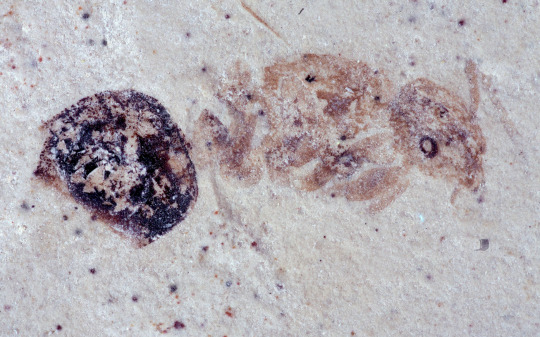
Sometimes a fossils are like photographs. These ants preserved in the Green River seem like they could come alive and walk right out of the stone.
Most fossils of ants are found in amber, due to their small size, sedimentary fossils must have exceptional fine grain detail to make ants recognizable.
The first image is from University of Colorado collection.
https://fossilinsects.colorado.edu/
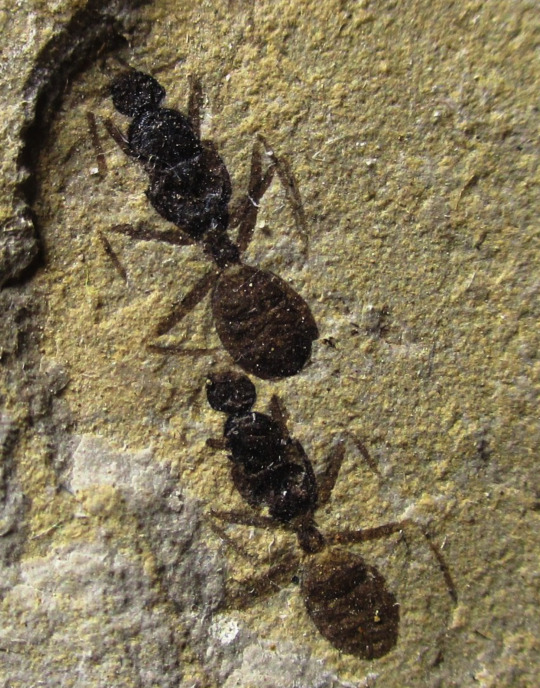
The second image I've been trying to track down-- I don't know where it is, but it is from Green River.

That first fossil is so beautiful I could cry. Look at her eye! what did she see in the Eocene? This at the dawn of the Age of the Ants... did she know her kind would inherit the whole world?
#ants#antposting#bugs#bugblr#insects#invertebrates#ant#antblr#myrmecology#antkeeping#fossil#green river#insect fossil#arthropod#arthropods#eocene
120 notes
·
View notes
Text

A fossilized tooth of an indeterminate basilosaurid, possibly Basilosaurus isis from the Samlat Formation in Dakhla, Morocco. It is unclear if the larger teeth from these ancient whales can be attributed to Basilosaurus.
#synapsid#mammal#fossils#paleontology#palaeontology#paleo#palaeo#basilosaurus#dorudon#cetacean#whale#eocene#cenozoic#prehistoric#science#paleoblr#fossil friday#fossilfriday#バシロサウルス#ドルドン#化石#古生物学
104 notes
·
View notes
Text
FEBUZOIC DAY 4
Queensland, Australia - Ypresian stage, 55Ma before present

300,000 years ago, the planet experienced a short, geologically speaking, spike in temperatures that caused somewhere between 5-8C of warming. This spike marked the transition from the Palaeocene epoch to the Eocene, and although the event is over, the already hot world of the Cenozoic is slowly getting hotter. Dawn breaks on a greenhouse planet.
As the light touches the shores of lake Murgon, the last of the bats retreat into the shadows, and the crocodiles, giant snakes and odd wading birds that line the shore are revealed. The plethora of water-loving insects begins to hum in the suns rays, but their noise in punctured by a new sound; birdsong. A small, relatively unassuming looking bird hops along the rocks of the shoreline, stopping occasionally to produce short bursts of complex vocalisation. He is a one of the first passerines, a group that in the modern day contains around half of all bird species, from crows to blackbirds to the New Zealand rock wren.
Birds, the only dinosaurs to have survived the extinction event 11 million years ago, have exploded in diversity and are now fulfilling a huge number of roles in the ecosystem. There are now a huge amount of birds calling to eachother in the dawn, and the songs of this little bird pick it out from the crowd of not just other bird species, but other birds of the same species. As time passes, the evolutionary process will select for more and more intricate songs until they arrive in the Holocene in their beautiful modern form.
#Eocene#palaeostuff#anthem posts#anthems art#palaeontology#paleoart#palaeoart#palaeoblr#passeriformes#FYI the fossil this part is based off is fragmentary and it is currently in question as to whether it is actually even a passeriforme at al#but ultimately its a bird its a miracle if any of them fossilise the first passerine could be living in hordes at Murgon and we'd never kno#Febuzoic 2024
60 notes
·
View notes
Text
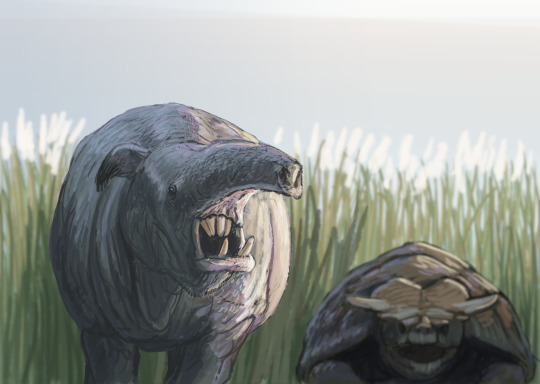
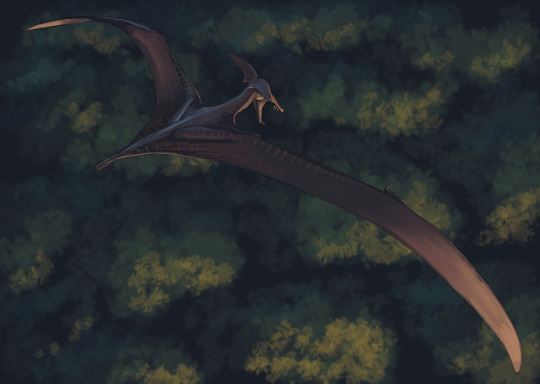


Results from the #paleostream! Propyrotherium, Cryptopneumon (for Dekerrex), Robinsondipterus and Multoisda duinlecebra (for @petitepaleoartist) If you too want a wish fulfilled, buy one of the books I illustrated and post about it on social media!
456 notes
·
View notes
Text
Pachycetinae: The Thick Whales
Oh look I'm way behind not only on my work with wikipedia but also in regards to summarizing it on tumblr. Good thing, three of the pages I've worked on these past few months can just be summed up in one post because they are all one family.
So Pachycetinae, at the most basic level, are basilosaurid archaeocetes, the group that famously includes Basilosaurus and Dorudon. Reason I've picked up the articles in addition to my usual croc work, basically a friend and I noticed how lacklustre many pages are and stupidly decided to start revising all of Cetacea (pray for me).
Currently theres two genera within the group. Pachycetus aka Platyosphys aka Basilotritus, which is a whole mess I will get into at the end for those interested, and Antaecetus, which I'll just call "the good one" for now. Among those are three species. Pachycetus paulsonii (or Basilotritus uheni) from continental Europe (Germany and Ukraine mostly), Pachycetus wardii (Eastern United Staates) and Antaecetus aithai (Morocco and Egypt)
Picture: Pachycetus and Antaecetus by Connor Ashbridge


So the hallmark of Pachycetines, as the name would suggest, is the fact that their skeletons are notably denser than that of other basilosaurids. The vertebrae, the most abundant material of these whales, are described as pachyostatic and osteosclerotic. The former effecitvely means that the dense cortical bone forms thickened layers, while the latter means that the cortical bone, already forming thickened layers, is furthermore denser than in other basilosaurids with less porosities. The densitiy is increased further by how the ribs attack to the vertebrae not through sinovial articulation but through cartilage, so adding even more weight to them. Overall this is at times compared to manatees, famous for their dense skeletons.
Pictured below, the currently best preserved pachycetine fossil, an individual of the genus Antaecetus from Morocco.

Now there are some interesting anatomical features to mention that either differ between species or just can't be compared. For example the American species of Pachycetus, P. wardii, shows a well developed innominate bone, basically the fused pelvic bones. This is curious as one would think of it as a more basal feature, with derived whales gradually reducing them. The skull is best preserved in Antaecetus and has a very narrow snout. One way to differentiate the two is by the teeth. Pachycetus has larger, more robust teeth while that of Antaecetus are way more gracile and is thought to have had a proportionally smaller skull (in addition to being smaller than Pachycetus in general).
All of this has some interesting implications for their ecology. For instance, why the hell are they so dense? Well its possible that they were shallow water animals using their weight as ballast, staying close to the ocean floor. This would definitely find some support in the types of environments they show up in, which tend to be shallow coastal waters. There are some Ukrainian localities that suggest deeper waters, but that has been interpreted as being the result of migration taking them out of their prefered habitat.
Now while pachycetines were probably powerful swimmers, their dense bones mean that they were pretty slow regardless. And to add insult to injury, they were anything but maneuverable. Remember those long transverse processes? Turns out having them extend over the majority of the vertebral body means theres very little space for muscles in between, which limits sideways movements.
From this one can guess that they weren't pursuit predators and needed to ambush their prey. What exactly that was has been inferred based on tooth wear. Basically, the teeth of Pachycetus show a lot of abrasion and wear, not dissimlar to what is seen in modern orcas that feed on sharks and rays. And low and behold, sharks are really common in the same strata that Pachycetus shows up in. Now since Antaecetus had way more gracile teeth, its thought that it probably fed on less well protected animals like squids and fish.
Below: Pachycetus/Basilotritus catching a fish by @knuppitalism-with-ue

The relationship between pachycetines and other basilosaurids is wonky, again no thanks due to Pachycetus itself being very poorly known. Some studies have suggested that they were a very early branching off-shoot, in part due to their prominent hip bones, but in the most recent study to include them, the description of Tutcetus, they surprisingly came out as not just the most derived basilosaurids but as the immediate sister group to Neoceti, which includes all modern whales. Regardless, in both instances they seem to clade closely with Supayacetus, a small basilosaurid from Peru.
And now for the part that is the most tedious. Taxonomy and history.
Remains of pachycetines have been known for a while and were first described as early as 1873 by Russian scientists. To put into perspective how old that is. The material's history in science predates both World Wars, the collapse of the Russian Empire and even the reign of Tsar Nicholas II. Now initially the idea was to name the animal Zeuglodon rossicum, but the person doing the actual describing changed that to Zeuglodon paulsonii reasoning that it would eventually be found outside of Russia (something that aged beautifully given that Ukraine would eventually become independent).
And this is where the confusion starts to unfold. Because at the same time people unearthed pachycetine fossils in Germany too, which would come be given the name Pachycetus (thick whale) and be established as two species. Pachycetus robustus and Pachycetus humilis, both thought to be baleen whales.
Pictured below: Pierre-Joseph van Beneden who coined Pachycetus and Johann Friedrich Brandt who described Zeuglodon paulsonii. Beneden easily has the better beard.
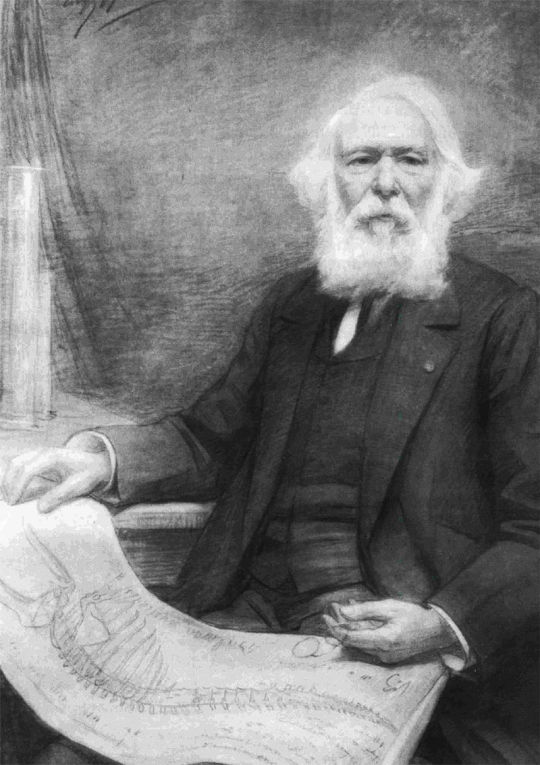

These latter two names however were later rejected in 1935 by Kuhn and lumped into other species, whereas Zeuglodon paulsonii was elevated to a full on new genus by Remington Kellogg in 1936. For those curious, Platyosphys means "broad loin", in combination with the species "Paulson's broad loin" to the amusement of some friends of mine.
And then people stopped caring and we have a nearly 70 year research gap. Eventually Mark D. Uhen found fossil material in the United States, but interpreted those fossils as being part of the genus Eocetus, naming them Eocetus wardii, a move that many following researchers disagreed with.
Then in 2001 a new species of Platyosphys, P. einori, was named. It's bad, moving on. More importantly, we got the works of Gol'din and Zvonok, who attempted to bring some clarity into the whole thing. To do so they rejected the name Platyosphys on account of the holotype having been lost sometime in WW2 and picked out much better fossil material to coin the genus Basilotritus ("the third king" in allusion to Basilosaurus "king lizard" and Basiloterus "the other king", isn't etymology fun?). They erected the type species Basilotritus uheni and then proclaimed Eocetus wardii to also belong into this genus, making it Basilotritus wardii.
This move was however not followed by other researchers. Gingerich and Zhouri maintained that regardless of being lost, Platyosphys is still valid and can be sufficiently diagnosed by the original drawings from the 19th and early 20th century. And to take a step further they added a new species, Platyosphys aithai (weird, why does that name sound familiar).
Then Van Vliet came and connected all these dots I've set up so far, noting that the fossils of Platyosphys are nearly identical to those of Pachycetus. This lead to the fun little thing were "paulsonii", applied first to Zeuglodon in the 1870s, takes priority over "robustus", coined just a few years later, BUT, the genus name Pachycetus easily predates Platyosphys by a good 60 years. Subsequently, the two were combined. Platyosphys paulsonii and Pachycetus robustus became Pachycetus paulsonii (simplified*). Van Vliet then deemed humilis to be some other whale and carried over Basilotritus uheni, Basilotritus wardii and Platyosphys aithai into the genus Pachycetus. *Technically Pachycetus robustus was tentatively kept as distinct only because of how poorly preserved it was, making comparisson not really possible.
Then finally in the most recent paper explicitly dealing with this group, Gingerich and Zhouri came back, killed off P. robustus for good, sunk Pachycetus uheni into Pachycetus paulsonii for good measure and decided to elevate Pachycetus aithai to genus status after finding a much better second skeleton, coining Antaecetus (after the giant of Greek myth).
And that's were we are right now. Three species in two genera, but only one of them is actually any good. So perhaps at some point in the future we might see some further revisions on that whole mess and who knows, perhaps Basilotritus makes a glorious comeback.
To conclude, sorry about the lack of images, despite the ample history theres just not much good material aside from that one Antaecetus fossil and I didn't want to include 5 different drawings in lateral view.
Obligatory Wikipedia links:
Pachycetinae - Wikipedia
Antaecetus - Wikipedia
Pachycetus - Wikipedia
Ideally Supayacetus will be the next whale I tackle, distractions and other projects not withstanding (who knows maybe I'll finally finish Quinkana)
#pachycetinae#pachycetus#basilotritus#platyosphys#antaecetus#archaeocete#prehistory#paleontology#palaeoblr#basilosauridae#eocene#whale
157 notes
·
View notes
Text
Waltonirrisor tendringensis Mayr & Kitchener, 2024 (new genus and species)

(Specimens of Waltonirrisor tendringensis [scale bars = 5 mm], from Mayr and Kitchener, 2024)
Meaning of name: Waltonirrisor = Walton-on-the-Naze Irrisor [defunct genus name for the green woodhoopoe, now in the genus Phoeniculus]; tendringensis = from Tendring
Age: Eocene (Ypresian), 54.6‒55 million years ago
Where found: London Clay Formation, Essex, U.K.
How much is known: Partial skeletons of at least three individuals and several isolated bones, together representing various limb bones, a vertebra, and a partial lower jaw.
Notes: Waltonirrisor was a close relative of hoopoes and woodhoopoes, a group of boldly-colored birds with long, curved bills. Specimens of Waltonirrisor had been previously figured in a 1998 paper, but were left unnamed at the time. Waltonirrisor was larger than most other Paleogene hoopoe-like birds, but smaller than extant hoopoes and woodhoopoes. It is the oldest hoopoe-like bird currently known.
A partial humerus (upper arm bone) from the Eocene of Germany may also belong to this genus.
Reference: Mayr, G. and A.C. Kitchener. 2024. The Picocoraciades (hoopoes, rollers, woodpeckers, and allies) from the early Eocene London Clay of Walton-on-the-Naze. PalZ advance online publication. doi: 10.1007/s12542-024-00687-9
37 notes
·
View notes
Text

Day 15 - Dentaneosuchus, not a dinosaur but a crocodylomorph from the Middle Eocene, described this year, the biggest predator of their enviroment
105 notes
·
View notes